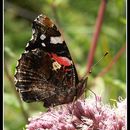Biology
provided by Arkive
Red admirals arriving in Britain following migration have usually mated before commencing their journey. Those that have overwintered in Britain mate after emergence.
Females lay their eggs singly on nettle leaves, and after about a week the eggs hatch (3). The caterpillars create a tent-like shelter from nettle leaves, in which they feed and pupate (3). The adults emerge after 2-3 weeks (3); they either hibernate or migrate southwards towards the end of summer. In southern Britain, it has been discovered that eggs and caterpillars are able to survive the winter, and emerge in the adult form in spring (2).
Conservation
provided by Arkive
Conservation action has not been targeted at this widespread and common butterfly.
Description
provided by Arkive
The red admiral is a familiar butterfly, and is easy to identify thanks to its striking patterning; the black forewings feature prominent red bars and white spots. The undersides of the hindwings are delicately patterned with brown and black (1), which provides excellent camouflage when this butterfly is roosting on tree trunks (2). The caterpillar grows to 3.5 cm in length, and occurs in a number of forms of varying colour. Dark forms are greyish-black, and have black spines and yellow patches along each side. Various pale forms also occur; they are either green or yellowish with pale spines and black markings (3).
Habitat
provided by Arkive
Occurs in a huge range of habitats, usually where the most important caterpillar foodplant, the common nettle (Urtica dioica) occurs (2). Adults are often seen in gardens feeding on nectar on buddleias (such as Buddleja davidii), or feeding on rotten fruit (2).
Range
provided by Arkive
This common migratory species has a wide distribution throughout Britain. Adults emerge after hibernation in January and March, and are joined by butterflies that have migrated from North Africa and southern Europe between May and August. As the summer progresses, further immigrants arrive from Spain and Portugal, and later still from central Europe and France (2). After mid-August red admirals in Britain begin to move southwards and the majority spend the winter in warmer climes (2). Globally, this butterfly has a wide distribution, and is known across central and southern Europe, Asia, North Africa and North America (2).
Status
provided by Arkive
This widespread and common species is not threatened. It is not listed under any conservation designations (2).
Threats
provided by Arkive
This species is not currently threatened.

